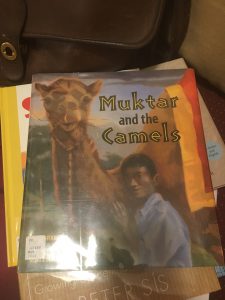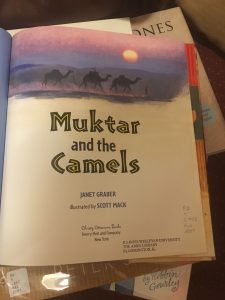Author(s)/ Illustrator/Photographer: Janet Graber, Scott Mack
Publisher and Year Number of pages: Henry Holt and Company, 2009, 29 pages.
Genre: Fiction

Descriptive Annotation: The cover features an artistic rendering of the protagonist, Muktar, with a camel, done in some lovely shades of watercolors that are throughout the book. There is a brown camel on a navy-blue background, and the shirt Muktar is wearing is a similar shade of blue, perhaps leading the reader to infer that Muktar himself is a fixture of the natural world as well, not disturbing the equilibrium that Mother Nature has set. As for the book itself, it involves the engrossing story of Muktar, a Somalian refugee who has found a refuge in Kenya but still misses his homeland and the tending of camels he used to do there. Muktar gets his chance to take up his old passion when a traveling librarian, Mr. Mohamed enters the refugee camp in Kenya in which he resides. Mr. Mohamed reached the town the camp is a part of, Garissa, by camel back, and soon Muktar’s troubles are alleviated somewhat by the presence of the three camels-a new, dynamic trio of mammalian friends. The teacher of the school Muktar attends, Mr. Hassan, always called him lazy and shiftless before in the classroom, but stops doing so now that he sees the young man’s ability to take care of Mr. Mohamed’s camels so well. Luckily for the reader, despite the complex geopolitical situation in East Africa, the story contains universal themes -feeling like an outsider, trying to fit in when in a new place, and getting a true sense of belonging in unfamiliar locales. This is accompanied by the equally universal themes of those three bad things hanging over your head until there is an activity or valve to release the feelings of loneliness and isolation that can easily plague even the most levelheaded person. There is some background information provided at the end to help the precocious reader truly enjoy this story as well learn about the turmoil Somalia has gone through since 1993, and how it has exacerbated the flow of refugees out of the nearly lawless country.
Classroom Application: A central theme is the acceptance of others despite their differences, and the description of world events make this an ideal text to teach those lessons to students. The author and illustrator demonstrate that stigmatization isn’t the best avenue to pursue when new or different people enter your community, and how the children best learn this lesson would be up to the teacher. The passion shown by the main character in pursuing his goal of camel tending and acceptance from his peers in the camp (and Kenyans in general) is certainly a good lesson for teaching purposes. One possible lesson after reading the book would be to follow the news coming out of two current conflicts-Syria as mentioned in the Stepping Stones review, and Yemen-or even Somalia, which is still run by a weak government, and tie that into classroom curriculum. Students will also hopefully recognize, as Mr. Hassan does at the end of the story about Muktar, that we all have a purpose on this Earth, and at some point, we all need a person to “take care of the…ornery beasts” (Graber, p. 25) in our lives.
Linguistic and Cultural Diversity Analysis: The book’s setting is along the Kenyan-Somalian border, and the unique cultural blend formed in that region in recent years due to the combination of cultures from refugee movements is depicted and would be great material for a social studies-type course. The traditions of the Somali peoples that originally only stayed in Somalia have dispersed everywhere from Nairobi to Minneapolis, and are now present in the fabric of each city’s social structure. Graber explains this concept to the reader through the character of Muktar, who is an orphaned young man that ran away from a war-torn country with his nomadic family. Tragically, he was the only one who made it out alive, and his “…mother and father rest in graves beneath piles of stones” (Graber, p. 6). The Somali people from Muktar’s region of the country have always been committed to maintaining and supporting their camel herds, and Muktar’s father hammered that lesson home whenever he could: “Camels first. Always camels first. Camels are treasure” (Graber, p. 5). His zeal that he got from his late parents to take care of these animals convinces Mr. Mohamed to take him on his travels across the continent, and Mr. Hassan allows it when he sees the boy so happy about caring for the animals rather than depressed about his situation.

